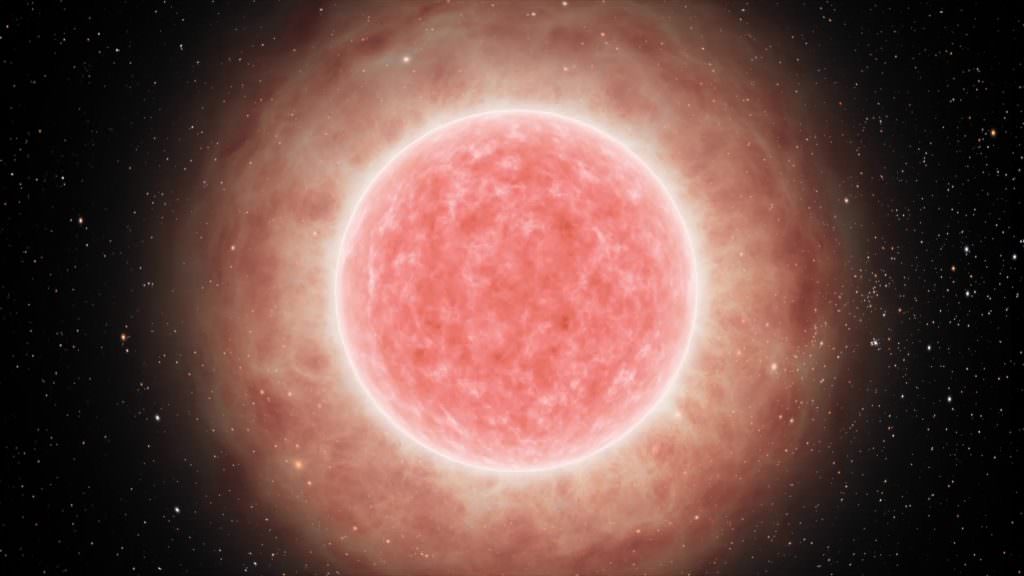Twinkling Stars Supply the Dust That Leads to Life
By Matt Williams
When low to medium-mass stars exhaust their supply of hydrogen, they exit their main sequence phase and expand to become red giants – what is known as the Asymptotic Giant Branch (AGB) phase. Stars in this phase of their evolution become variable (experiences changes in brightness) to shed their outer lays, spreading dust throughout the interstellar medium (ISM) that is crucial to the development of planetary nebulas and protoplanetary systems. For decades, astronomers have sought to better understand the role Red Giant stars play.
Studying interstellar and protoplanetary dust is difficult because it is so faint in visible light. Luckily, this dust absorbs light and radiates brightly in the infrared (IR), making it visible to IR telescopes. Using archival data from now-retired Akari and Wide-field Infrared Survey Explorer (WISE) missions, a team of Japanese astronomers conducted the first long-period survey of dusty AGBs and observed that the variable intensity of these stars coincides with the amount of dust they produce. Since this dust plays an important role in the formation of planets, this study could shed light on the origins of life.
The study was conducted by doctoral student Kengo Tachibana and his colleagues from the University of Tokyo’s Institute of Astronomy. They were joined by astronomers from the University of Kagoshima, the University of Tohoku, and the Institute of Space and Astronautical Science (ISAS) at the Japan Aerospace Exploration Agency (JAXA). Their paper, “Investigation of mid-infrared long-term variability of dusty AGB stars using multi-epoch scan data of AKARI and WISE,” recently appeared in the Publications of the Astronomical Society of Japan.

Infrared astronomy has opened new insight into the Universe, as demonstrated by the James Webb Space Telescope (JWST). The JWST has provided the most detailed images of the cosmos ever seen thanks to its large primary mirror, IR instruments, and Sunshield (which keeps it at cryogenic temperatures). However, it’s important to note that Webb is the latest in a long line of IR observatories, which include AKARI (Japan’s first IR space telescope), the ESA’s Herschel Space Observatory, and NASA’s WISE and Spitzer space telescopes.
As Tachibana explained in a recent UTokyo press release, most IR surveys have been short-lived, which has limited opportunities to learn more about fainter stars and those that are nearing the end of their life cycles:
“We study stars, and IR light from them is a key source of information that helps us unlock their secrets. Until recently, most IR data was from very short-period surveys due to the lack of advanced dedicated platforms. But missions like AKARI and WISE have allowed us to take longer-period surveys of things. This means we can see how things might change over greater time periods, and what these changes might imply. Lately, we turned our attention to a certain class of star known as asymptotic giant branch stars, which are interesting because they are the main producers of interstellar dust.”
Interstellar dust consists of heavier elements (carbon, oxygen, iron, etc.) created by nuclear fusion within a star’s interior. These elements were originally formed by the first stars in our Universe (Population III stars) and accumulated in their outer layers. Once they reached the need of their lifespans, these outer layers were blown off through supernovae and dispersed throughout the cosmos. These elements then became part of the nebulae from which new populations (Population II and I formed), gradually increasing the metal content (“metallicity”) of stars.

Over time, these stars entered their AGB phase and became the main source of cosmic dust. But unlike Population III stars, AGBs produce and distribute heavier elements gradually into the ISM, shedding them from their outer layers rather than blowing them off in massive explosions. While astronomers have understood this for decades, the main drivers of this process are poorly understood, leading them to wonder where they should be looking to learn more about it. Said Tachibana:
“Our latest study has pointed us in the right direction. Thanks to long-period IR observations, we have found that the light from dusty AGBs varies with periods longer than several hundred days. We also found that the spherical shells of dust produced by and then ejected by these stars have concentrations of dust that vary in step with the stars’ changes in luminosity. Of the 169 dusty AGBs surveyed, no matter their variability period, the concentrations of dust around them would coincide. So, we’re certain these are connected.”
This study has provided a valuable first step by demonstrating the connection between dust concentrations and the variability of a star’s brightness. For the next step, the team hopes to explore the possible physical mechanisms behind the production of this dust. To do this, the team plans to use the 6.5-meter telescope at the University of Tokyo Atacama Observatory (TAO) in Chile. TAO is nearing the completion of the MIMIZUKU mid-infrared imager and spectrograph, which has spatial resolution comparable to that of the JWST’s Mid-Infrared Instrument (MIRI).
Using this instrument, the team intends to monitor various AGB stars continuously for many years. Alongside Webb and other next-generation IR observatories, these studies will reveal a great deal about the unseen aspects of our Universe.
Further Reading: University of Tokyo, Publications of the Astronomical Society of Japan
The post Twinkling Stars Supply the Dust That Leads to Life appeared first on Universe Today.

April 14, 2023 at 11:48PM
via Universe Today read more...

Post a Comment